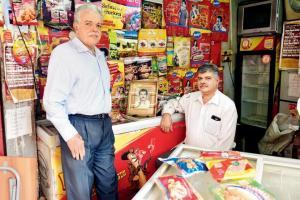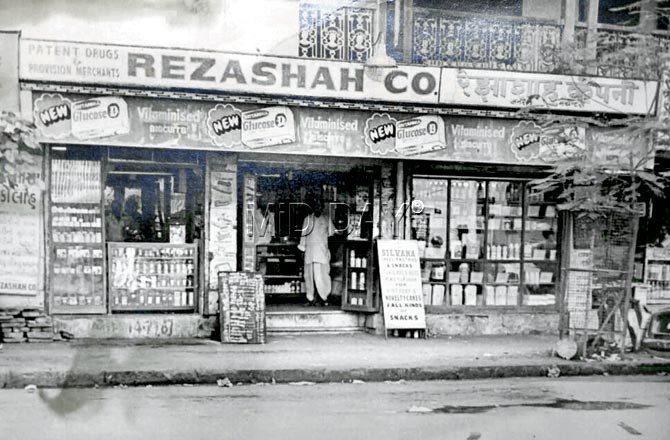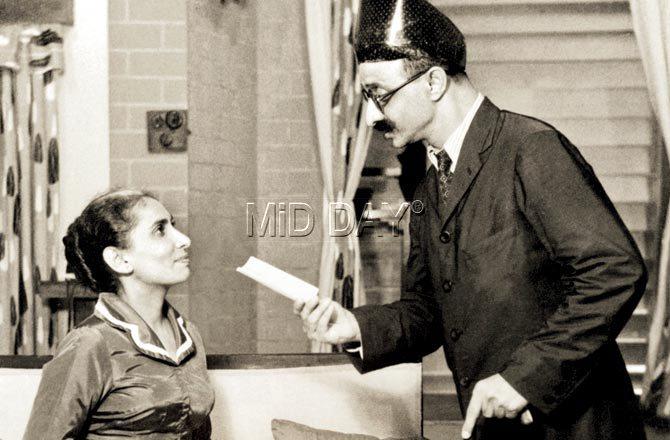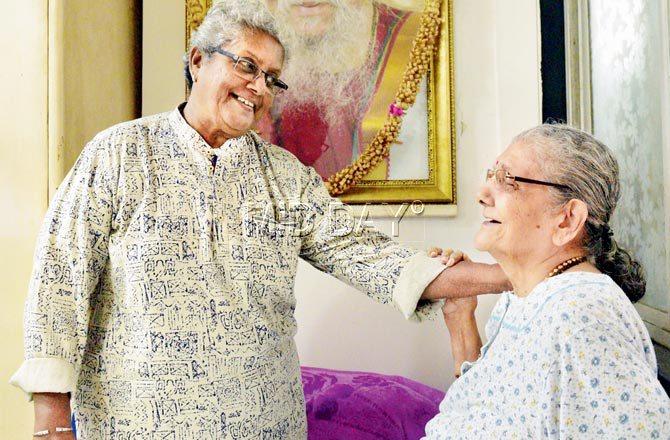Sleater Road, off Nana Chowk, is one of Bombay's most engaging paths leading to a railway station with stories of freedom and gossip and wrestling to fill its corners

Phiroze and Hoshang Contractor at Tarachand Cold Storage with a photograph of their father Dara who introduced frozen meats to the city, along with Mafco
 It's a quietly dramatic road. On which a boat maker sailed simple crafts to ferry residents marooned by rain floods. Where doctors declared that a flour mill left the area's housewives wheezing with asthma (men out at work day-long were less affected). Where, on the eve of the Emergency, activists vanished underground from a building that has stoked much political plotting and planning.
It's a quietly dramatic road. On which a boat maker sailed simple crafts to ferry residents marooned by rain floods. Where doctors declared that a flour mill left the area's housewives wheezing with asthma (men out at work day-long were less affected). Where, on the eve of the Emergency, activists vanished underground from a building that has stoked much political plotting and planning.
ADVERTISEMENT
Leading off Nana Chowk to Grant Road Station till Tardeo Bridge, Sleater Road stands on BB&CI Railway land. Commemorating JM Sleater, its Chief Engineer in the 1880s, this was renamed Naushir Bharucha Marg in honour of the corporator-MLA credited for concretising the road, among the first tarred in South Bombay.

Two Sleater House blocks line the left side of the road
I hear snatches of Sleater Road lore from Aban and Purvez Patel at Dhunbad, erected in 1937 when architect Nusserwanji Poonegar drafted other neat buildings of its kind along their stretch. Pointing from the balcony to a 100-year-old peepal, Aban says, "Except that there were more trees, our side of the street stays how we've always known it."
Sunil Ullal, from 1948-built Ganesh Prasad, formerly the Roychowdhury bungalow, agrees. "The right flank of the road is structurally the same. Opposite, with my colony and Sonawala Building, the road gets cosmopolitan." His neighbour Anil Kandlur shares how popular fixtures like Light of India haircutting saloon in Petit Mansion disappeared following the 1993 communal riots.

Rezashah Co. was named for the Shah of Iran ascending the throne in the year that Hormajshah Andhyarujina of Udwada hit business on Sleater Road. Pic Courtesy Rointon Andhyarujina
At Ganesh Prasad, I meet the family of Bharatnatyam doyen Guru Parvati Kumar, who shaped the career of exponents including Sandhya Purecha and cinema choreographer PL Raj. The Std V dropout from a Parel municipal school earned mill worker wages and recreated Uday Shankar's ballet poses at Ganpati pandals. Learning classical dance, he shifted to Sleater Road to teach from the room we sit in. His cricket coach daughter Aparna shows a video clip of her mother Sumati swirling at 16 to "Suhana hain yeh mausam" from the film Footpath. "I wanted to dance under Raj Kapoor's direction," the octogenarian smiles. She did in the Awaara dream sequence, at one-third the fee compared with R600 for the Footpath song, which she splurged on painting her Sonawala Building home.
Ganesh Prasad's living legend is Dr GG Parikh – "first to occupy this genuinely cooperative society in 1950", says the spry-at-94 socialist. Fervent nationalism raged on and around Sleater Road. Parikh's freedom hero Yusuf Meherally, coining the slogans "Simon go back" and "Quit India", lived nearby on Raghavji Road. Badly beaten for demonstrating against the Brits, Meherally was also rolled in a barrel from the top of Grant Road Bridge.

Hilla and Nader Nariman in a playful scene from Adi Marzban’s 1958 caper, Chhupo Rustom. The veteran actor couple lived at Sleater House. Pic Courtesy Meher Marfatia/Laughter in the house
The morning we meet, Parikh has stolen moments from his medical practice, duties at the Yusuf Meherally Study Centre which he established in 1961 and co-editing Janata, the Praja Socialist Party magazine since 1946. Parikh was imprisoned for picketing at Churchgate in August 1942. With fellow patriots Damu Jhaveri and Rohit Dave, he realised three dreams they dared to have in jail: forming Indian National Theatre, All India Students Congress and Hind Mazdoor Sabha. The good doctor champions rural development in Panvel's tribal village of Tara which he visits twice-weekly.
This is Landmark Lane – famous for Girton High School, JD Bharda School and Lady Engineer School at the Kotwal Bungalow on this road (before its present Tardeo space), as well as Wallace Flour Mills, Mithaiwala Agiary and, of course, Grant Road Station. Named for Sir Robert Grant, 1830s Governor of Bombay, the originally roofed terminus connected trains to Surat. Smack within the station you could tread through Alice Restaurant, stepping on the street with moist plum cake and crisp khari biscuits.

(Right) An accomplished dancer herself, Sumati Kambli shares a moment with daughter Aparna at their Ganesh Prasad home, below the portrait of her husband, Bharatnatyam guru Parvati Kumar. Pics/Bipin Kokate
The chug and swoosh of trains are welcome sounds falling on Parviz Katrak's ears at Sleater House, close enough to afford fine platform views from her dining room window. "I feel lost without the noisy rattle if awake between 1.30 and 4.30 in the morning when trains stop," she laughs. So it is too for nonagenarian Rutty Manekshaw of Station Terrace. Sooni Taraporevala's aunt, who expertly translated wicked Gujarati phrases for the book Parsi Bol, Manekshaw remembers the extended family in Hormuzd Building, Jaiji Terrace and Gool Mahal. "Sooni's mother Freny and her sisters were very pretty but strictly brought up; whisked inside if they stood looking out from their ground floor verandah."
Katrak and Manekshaw rejoice that parts of Sleater Road such as Wimbridge Compound (where Edward Wimbridge, who designed the cover and engraved the heading of The Theosophist's inaugural issue in 1879, had a furniture factory) retain their essence. They recall amusing diversions. One block down, a family brewed kegs of vinegar smelling tart for miles. The Sleater Road Parsi Mandal encouraged the lane's little old ladies to glean gossip amid some superficial chat about civic affairs. The gully adda of Ramu Dada caused crazy traffic jams at 8.30 pm. As crowds of gamblers gathered, each hoping to hit the satta jackpot, the matka king shouted a nifty ditty: "Bawa aao, buwa aao, bus naseebwala mat aao (Come one, come all, only the lucky mustn't come)!"
Across Sleater House, the Wallace Flour Mills, commissioned in 1889 by Vissanji Khimji with a 40-ton daily capacity, pioneered bulk storage of wheat in concrete silos and introduced automatic rapid packaging in 1962. Girton High School, funded in 1888 by Miss Moos (her friend, Miss Prescott, principal of Frere Fletcher School at Fort, urged Moos to start a school suggestive of UK's Girton College from where Prescott graduated), moved here from Lamington Road in 1984. The government acquired 2,754 square yards for the Old Girtonians' Association Property Fund on the plot of the burnt Levka ship factory. Prescribed no uniform in the beginning, Girton girls teamed quaint ijar pants with smocked jhablas and embroidered caps.
A gentle giant, bodybuilder Tehmurasp Sarkari groomed reed-thin local lads to ripple-muscled confidence. The referee for international freestyle wrestling bouts involving Tiger Holden and King Kong (the 200-kg Aussie was hoisted by our 130-kg star pehlwan Dara Singh), Sarkari seldom charged students in his home gym. The street that was once an Irani bakery paradise is served solitarily by Rosaline in Chaman Chambers and struggling to survive Cafe Darayush which opened in 1968, with Khodadad Mondegar Irani as a main owner. "Few patrons now," his son Darayush says laconically, as his wife sews sadras on order and simmers tomatoes for what seems like a fragrant curry lunch.
Rezashah Co. was a street icon, ignominiously replaced by Golden Goose bar. Rointon Andhyarujina's father Hormajshah procured premises in Union Building from the Maharashtrian proprietor of a pickle shop called Bhonsle cha Loncha. He came to christen the venture rather interestingly –1941, the year he added a medical store, the last of seven Sleater Road outlets (after a grocery, egg mart, dairy farm, vermicelli counter, kerosene depot and sandalwood shop), marked the ascension of Mohammad Reza Shah Pahlavi to the Iran throne. Rointon says, "Arriving from his native Udwada, able to speak exactly four English words – 'Yes, No, Sorry, Thank you' – Dad actually ended up helping Congressman Homi Taleyarkhan script his political campaigns."
One of Rezashah's keen competitors was Tarachand & Co. A general store as far back as 1905, it became a laundry, a chemist and then the cold storage it is today since 1970. Phiroze and Hoshang Contractor's father Dara was trusted as the sole stockist of frozen meats besides Mafco. Not unexpectedly, the vicinity's vegetarian Jains have changed business trends in recent years.
Bang across Jai Hind Cold Drink House (its icy delights madly missed by old-timers), Belgaum Ghee Depot from 1943 continues greeting customers. Settling at a coveted junction he often saw riding past on tram Number 13, Hormusji Jogina sold pure ghee scooped in big 18 kg boxes trucked from Belgaum. Forty years ago, he diversified to supply snacks and traditional Parsi treats. These are hot in demand, so prepare to face bare counters should you crave akoori, achaar or heavenly soft-sweet maleedo a bit later in the day. Paras Watch Co. is pinned to a wall of Abhyankar Building from 1967, when Umesh Sanghvi's father Mugatlal from Saurashtra taught himself mechanical repair. "People still bring brands like Favre Leuba, Ansonia, Wehrle and Seikosha, for which I fabricate parts," Umesh says. "Who knows how long this will carry on?" Dwarfed by a dozen hideous towers and hotels, several small shopkeepers ask this question... huddled in the shadow of the city's ugliest skywalk, silhouetted monster-like against the dark clouds of yet another monsoon.
Author-publisher Meher Marfatia writes monthly on everything that makes her love Mumbai and adore Bombay. You can reach her at mehermarfatia@gmail.com
Catch up on all the latest Crime, National, International and Hatke news here. Also download the new mid-day Android and iOS apps to get latest updates
 Subscribe today by clicking the link and stay updated with the latest news!" Click here!
Subscribe today by clicking the link and stay updated with the latest news!" Click here!







